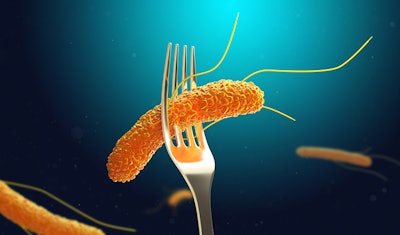
A new processing method, hydrated surface lethality (HSL), could protect smaller-sized meat and poultry products against Salmonella during cooking.
“Lots of poultry products go through fast cooking processes, like chicken nuggets, tenders and strips,” Jeff Sindelar, professor and extension specialist in the Department of Animal and Dairy Sciences, University of Wisconsin Madison, said.
“The results of this research support a very effective means of ensuring the safety of these products during internal processing.”
The challenges of Salmonella
Salmonella is gram-negative anaerobic bacterium that is responsible for approximately 1.35 million illnesses, 26,500 hospitalizations and 420 deaths in the U.S. each year, according to data from the Centers for Disease Control and Prevention (CDC). The bacteria has become increasingly multi-drug resistant, making it difficult to treat.
In addition, the bacteria is very adaptable to its environment. For example, in low-moisture conditions, Salmonella can become better at withstanding heat – becoming a food safety hazard for meat and poultry products cooked in dry-heat.
As a result, the U.S. Department of Agriculture (USDA) updated industry guidance in 2017 to require a 90% humidity level during meat and poultry cooking processes that take less than one hour to ensure food safety.
However, these guidelines caused several new challenges. Smaller-sized meat and poultry products, like chicken nuggets, are often cooked in impingement ovens. Impingement ovens, a continuous cooking system driven via conveyer belt, operate at high temperatures for a short time.
This process dries out Salmonella, making the bacteria more heat tolerant and better able to survive high temperatures.
Hydrated surface lethality
In a study published in Meat and Muscle Biology, the researchers designed, tested and validated a new processing method known as HSL or hydrated surface lethality. The method could maintain hydration on product surfaces to kill the bacteria.
“Hydrated surface lethality is a very effective means in focusing on a period of time where the surface of the product of the wet,” Sindelar explained. “Thus, if you know the surface of the product is wet where the bacteria is, you know you’ll have an effective kill.”
The process, which involves steams injection, satisfies the USDA guidelines and works on existing impingement ovens.
Kathy Glass, distinguished scientist and associate director of the Food Research Institute (FRI), alongside several industry partners, including Hormel Foods, Johnsonville Sausage, Jones Dairy Farm, SugarCreek Packing, Tyson Foods and ConAgra, also contributed to the research.
Like what you just read? Sign up now for free to receive the Poultry Future Newsletter


















